Reply To:
Name - Reply Comment
Last Updated : 2024-04-17 02:11:00

(Inset 5) ‘Pope and King’ ideal-leader type worships Sri Lankan ground

(Inset 7) Father’s masculine virility and generative capacity
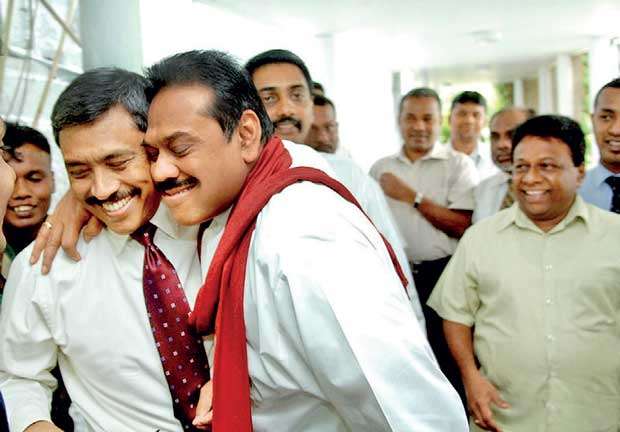
(Inset 6) Sibling fraternity is rewarded in Sri Lanka’s highly collectivist culture
 In 1996, a punishing drought crippled hydroelectricity generation and impacted households and industry with gruelling eight-hour blackouts. Thousands of farmers faced crop failure and bankruptcy as Chandrika Kumaratunga limped along without plan or purpose. “Her goals are impeccable but her execution seems faulty,” said the roving American journalist Ron Gluckman, observing that the weather had even turned against “Sri Lanka’s bad-luck president”.
In 1996, a punishing drought crippled hydroelectricity generation and impacted households and industry with gruelling eight-hour blackouts. Thousands of farmers faced crop failure and bankruptcy as Chandrika Kumaratunga limped along without plan or purpose. “Her goals are impeccable but her execution seems faulty,” said the roving American journalist Ron Gluckman, observing that the weather had even turned against “Sri Lanka’s bad-luck president”.
When rains failed
In contrast to Kumaratunga’s lacklustre response, consider Mahinda Rajapaksa’s reaction to the drought of 2012, with his prompt request to Indian Prime Minister Manmohan Singh to fly the Kapilvastu Relics, believed to be the bone fragments of the Buddha, from India’s National Museum in Delhi to Colombo.
The relics, conferred with the status of a head of state according to diplomatic convention, were revered as holy objects of awe by the thousands of faithful Buddhists who lined the streets to view, venerate and seek their intercessory powers for increased rainfall and bountiful harvests.
Symbolic power
 Through what I call symbolic power, leaders weaponize ideas, beliefs, behaviours, images and other culturally-relevant symbolic assets to shape the preferences of their followers. Symbolic power explains the psychological magnetism of the Narendra Modhi’s or Donald Trump’s of this world, who, as Indian political author Pankaj Mishra explains, understand the potency of images and symbols, oftentimes over rational argument and substance. Joseph Nye calls it the power of “positive attraction and persuasion” but you can just as easily think of it as seduction.
Through what I call symbolic power, leaders weaponize ideas, beliefs, behaviours, images and other culturally-relevant symbolic assets to shape the preferences of their followers. Symbolic power explains the psychological magnetism of the Narendra Modhi’s or Donald Trump’s of this world, who, as Indian political author Pankaj Mishra explains, understand the potency of images and symbols, oftentimes over rational argument and substance. Joseph Nye calls it the power of “positive attraction and persuasion” but you can just as easily think of it as seduction.
In the divisive world of politics – or any contest where brands (and that includes people and politicians) share points of parity – symbolic power tilts the balance by delivering competitive advantage to the leader who spins the most meaningful stories that resonate with his or her followers.
Take the powerful mythology that grew around Margaret Thatcher, tracing her absolute faith in the individual and championing of personal responsibility to the self-helping and thrifty values of her childhood, growing up as a grocer’s daughter. Or Junichiro Koizumi silently paying his respects to the souls of Japan’s war-dead at Yasukuni shrine, an action that targeted the conservative support base of the Liberal Democratic Party.
Or consider the former Irish Republican Army leader and Sinn Fein politician Martin McGuinness’ handshake with Queen Elizabeth in Belfast in 2012, as well as his decision to watch Northern Ireland play Germany in the 2016 European Football Championship.
Symbolic power also becomes essential when brands lack parity. Professor John Antonakis, a specialist in verbal and non-verbal leadership competencies, explains how political contestants who lack tangible power resources overturn more powerful and entrenched leaders and status quos by triggering higher visions in the minds of their target audience. They do this, explains Antonakis, through their voice, their face and their body.
And so Gandhi’s symbolic 250-mile ‘Salt March’ from Ahmedabad to the Indian Ocean at Dandi to produce salt from brine signalled the beginning of Indian resistance to the British Raj. Nelson Mandela personified black South Africa’s liberation movement during his 27-year captivity on Robben Island. A ban on his image by the apartheid state meant that a younger generation of activists didn’t know what he looked like; the more it “tried to erase his image, his words and his name,” says William Gumede, a former youth leader in the ANC, the more “activists revered him”.
The evocative language of Dr. Martin Luther King Jr’s ‘I have a dream’ speech – delivered at the end of the March on Washington from the steps of the Lincoln Memorial, under the gaze of America’s president who made an end to slavery the civil war’s moral cause – has since been taught in schools and universities, featured in documentaries and movies about the civil rights era, quoted by Barack Obama in his speeches and lyricized by Michael Jackson and rapper Common in their music.
Sometimes leaders rely on a unique garment or accessory, like Yasir Arafat’s trademark checkered kaffiyeh folded triangularly to resemble the map of Palestine. Margaret Thatcher’s personal style included her helmet hairstyle complete with pussy bow blouse and blue power suit; British ministers and civil servants even coined the term “handbagged” to refer to the black and square handbag the prime minister psychologically wielded against her opponents.
There are also religious leaders like the Pope, Mother Teresa, Sathya Sai Baba and the televangelist Soma Hamuduruvo, as well as the royal families in Britain and Japan who, lacking the executive power to enforce orders and influence national policy, reign symbolically.
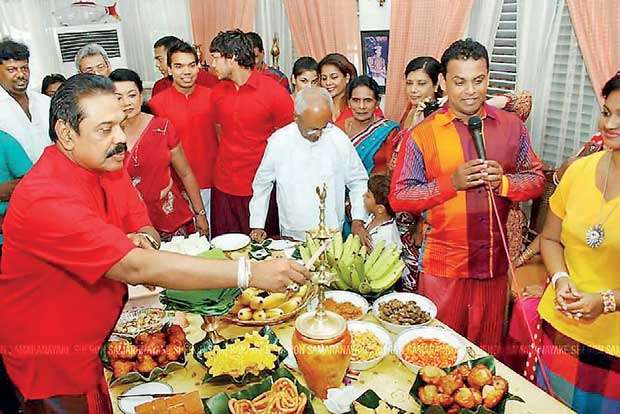
(Inset 8) Extended family is a valuable symbolic asset in a collectivist culture
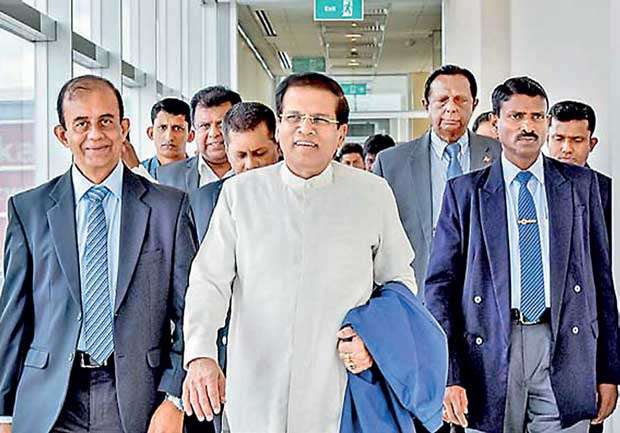
(Inset 2) President Maithripala Sirisena and his pirivara depart for Australia
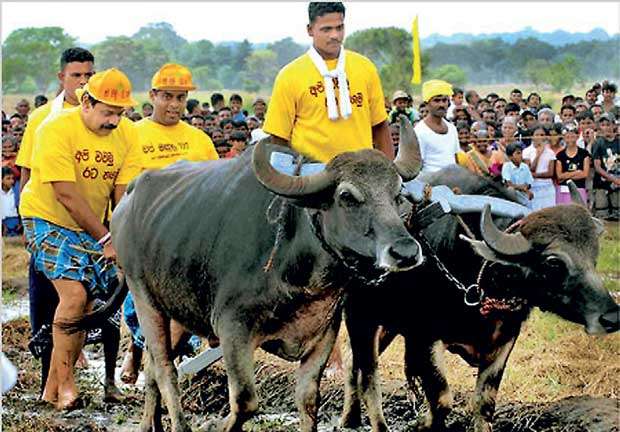
(Inset 4) Cultural practices that reinforce Rajapaksa’s bhumiputra credentials
In the Oscar-winning true-life drama ‘The King’s Speech’, a stammering King George VI asks his Australian speech therapist Lionel Logue, “If I’m a king where’s my power? Can I form a government? Can I levy a tax? Declare a war? No. And yet I’m the seat of all authority. Why? Because the nation believes that when I speak, I speak for them.”
When exercised effectively – as Mahinda Rajapaksa did during the drought in 2012 and for much of his presidency – symbolic power proves to be crucial in organising experience for followers and can even provide a sense of meaning and continuity between the past and present.
For example, Sri Lankan historian Dr. Michael Roberts, who has closely examined what he calls the “images and conceptions of authority which inform and underlie hierarchical relationships in Sinhala society”, gives us the useful example of how J.R. Jayewardene, drawing on the rich body of symbolic assets in Sinhala culture, “presented himself as the 193rd head of state since Vijaya and coined the term ‘devavahanse’ – a word which has divine and royal connotations – as the Sinhala equivalent of ‘His Excellency’ for use on occasions when people addressed him as President.”
These examples may seem trivial to the untrained eye but they tell us a few important things.
Symbolic power depends on willing receivers
First, symbolic power depends on the followers who are willing ‘interpreters’ and ‘receivers’. They believe in the legitimacy of the leaders’ objectives, which closely mirror their own ideals, wishes, desires and fantasies (as well as their fears and anxieties). One of Dr. Roberts’ most illuminating examples of how collective behaviours in a culture are acquired and transmitted symbolically by both leaders and followers is the retinue or ‘pirivara’.
In temples, the Buddha is frequently surrounded by attendants, acolytes and disciples (see Inset 1); the Buddhist clergy also refers to the arrival or departure of the Buddha as ‘pirivaragena’ or ‘accompanied by a retinue’. These symbolic images are behaviourally replicated by politicians in escorts and processions – D.B.S. Jeyaraj refers to them as “contrived crowds” – which include personal guards and motorcades (see Insets 2 and 3).
Symbolic power mirrors an ideal-type Sinhalese leader
Second, Rajapaksa’s and Jayewardene’s examples appeal to the Sinhala mainstream voters’ perceptions and expectations of an ideal-type leadership; Dr. Roberts explores how this pivots on the archetype of the wise and authoritarian monarch/king in mainstream Sinhala culture and how it is renewed and projected by followers onto their relationships with leaders.
He describes “a person and office which combines in himself/itself the authority of Pope and King … an authority marked by a top-down flow of authority [and] a relationship marked by weak reciprocity.”
The Buddhist clergy are the progenitors and raconteurs of this ideal-type leadership myth and repeatedly reinforce it within the influential setting of the Buddhist temple, a crucial Third Place of congregation and networking that Sri Lankan marketers have yet to explore and the present UNP leadership remains slow to grasp.
Symbolic power can be channelled but not controlled
Third, symbolic power frequently develops spontaneously, without leadership or directive, like the recent pro-democracy protests in Colombo against President Sirisena’s decision to dissolve Parliament or the Occupy Wall Street encampments with their “We are the 99%” call against gross economic inequality in America.
It can also be expressed, as Professor Antonakis shows us, through the body and gestures, such as the four-fingered anti-coup Rabia sign, which began as a symbol of resistance against a military coup against Mohamed Morsi in Egypt and subsequently became a symbol for protestors around the world (as I write this article, the Egyptian government has banned the sale of yellow reflective vests amid fears opponents might copy France’s gilets jaunes protestors during the anniversary of the 2011 uprising that toppled Hosni Mubarak); yet another example is the three-fingered salute in Suzanne Collins’ dystopian novel ‘The Hunger Games’, which protestors in Thailand imitated to signal their defiance of the country’s military government.
As all this makes clear, there is no easy way to define where symbolic power begins and where it ends. Just as a large measure of America’s global legitimacy is created in Hollywood and not the White House, this form of power originates in images, symbols and stories in the collective Sinhala psyche – not Temple Trees or the campaign strategies of any advertising agency.
Dr. Roberts traces their origin to folk story, religious myth, temple/devalaya iconography, tovil, gammaduvas, as well as the jataka stories on the Buddha’s previous lives. When J.R. Jayewardene claimed lineage through the executive presidency to Vijaya, he demonstrated the crucial leadership competency of identifying and targeting symbolic assets that were culturally meaningful to his followers.
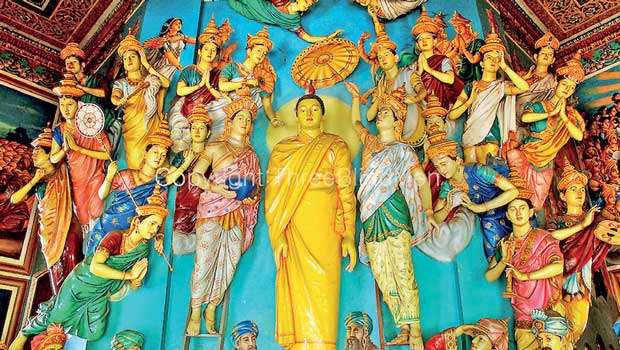
(Inset 1) The Buddha and his pirivara, Asokaramaya Temple, Thimbirigasaya (vd. Dr. Michael Roberts)
Symbolic power of Rajapaksa brand
Mahinda Rajapaksa deftly converted symbolic assets into realized power. His brick-red scarf or ‘sataka’ is a marker of community and symbolizes the coarse kurakkan millet consumed by impoverished farmers in Giruwapattuwa. He drove a team of bullocks to plough the soil at a traditional ‘Wap Magul’ ceremony (Inset 4), which D.B.S. Jeyaraj tells us is also a skill shared by his brothers; as the war drew to a close, he famously worshipped the ground at the Katunayake airport (Inset 5), closely mimicking the spiritual quality of the Pope.
When the LTTE narrowly missed assassinating his brother and former Defence Secretary Gotabhaya Rajapakse, he released a poignant photograph of sibling fraternity (Inset 6), made meaningful by the highly collectivist stance of mainstream Sinhala culture (the Hofstede Index describes a society that has “a close, long-term commitment to the member ‘group’, be that a family, extended family or extended relationships”, where “everyone takes responsibility for fellow members of their group”.) To put it simply, the mainstream Sinhalese voter rewards leaders who are perceived to be close to and who demonstrate care for, their families (Inset 8). The Rajapaksas regularly appear together in photographs, emphasizing the traditional two-parent nuclear family unit and its extended relationships that Ranil Wickremesinghe, his wife Maitree and their own family of brothers and sisters seem unwilling or unable to portray. In Inset 7, Shiranthi Rajapaksa presides over a powerful ritual of fertility and abundance, while Namal, Yoshita and Rohitha signal the masculine prowess and virility of their father and by association the generative capacity of the leader towards his nation.
Manfred Kets De Vries at INSEAD calls this ‘cultural management’ – a process that is part conscious and deliberate, part unconscious and intuitive – where canny leaders reinforce their own symbolic power and influence the behaviours of their followers in tacit and unconscious ways, through culturally-relevant meaning.
Of course, symbolic power in and of itself cannot win elections. As Rajapaksa learned the hard way at the 2015 presidential election and last year’s dissolution of Parliament, substance must keep up with symbolism and reality with rhetoric if leaders aren’t to face popular anger and rejection. And yet a deficiency in symbolic power is analogous to fighting with one hand tied behind your back. Mangala Samaraweera recently endorsed Prime Minister Ranil Wickremesinghe as the most suitable candidate for the 2020 presidential election, saying, “He is the one who knows where to lead the country without just entertaining the crowd.” Perhaps. But then again, leaders don’t rise in a vacuum; they come to power on the backs of their followers. And that requires symbolic power.
(Michel Nugawela heads the Interbrand Sri Lanka office. He can be reached at designs@michelnugawela.com)
MARA Wednesday, 09 January 2019 01:10 PM
When sycophants are afforded "typewriters" this is what the masses get. What a load of bootlicking garbage.

Add comment
Comments will be edited (grammar, spelling and slang) and authorized at the discretion of Daily Mirror online. The website also has the right not to publish selected comments.
Reply To:
Name - Reply Comment
On March 26, a couple arriving from Thailand was arrested with 88 live animal
According to villagers from Naula-Moragolla out of 105 families 80 can afford
Is the situation in Sri Lanka so grim that locals harbour hope that they coul
A recent post on social media revealed that three purple-faced langurs near t